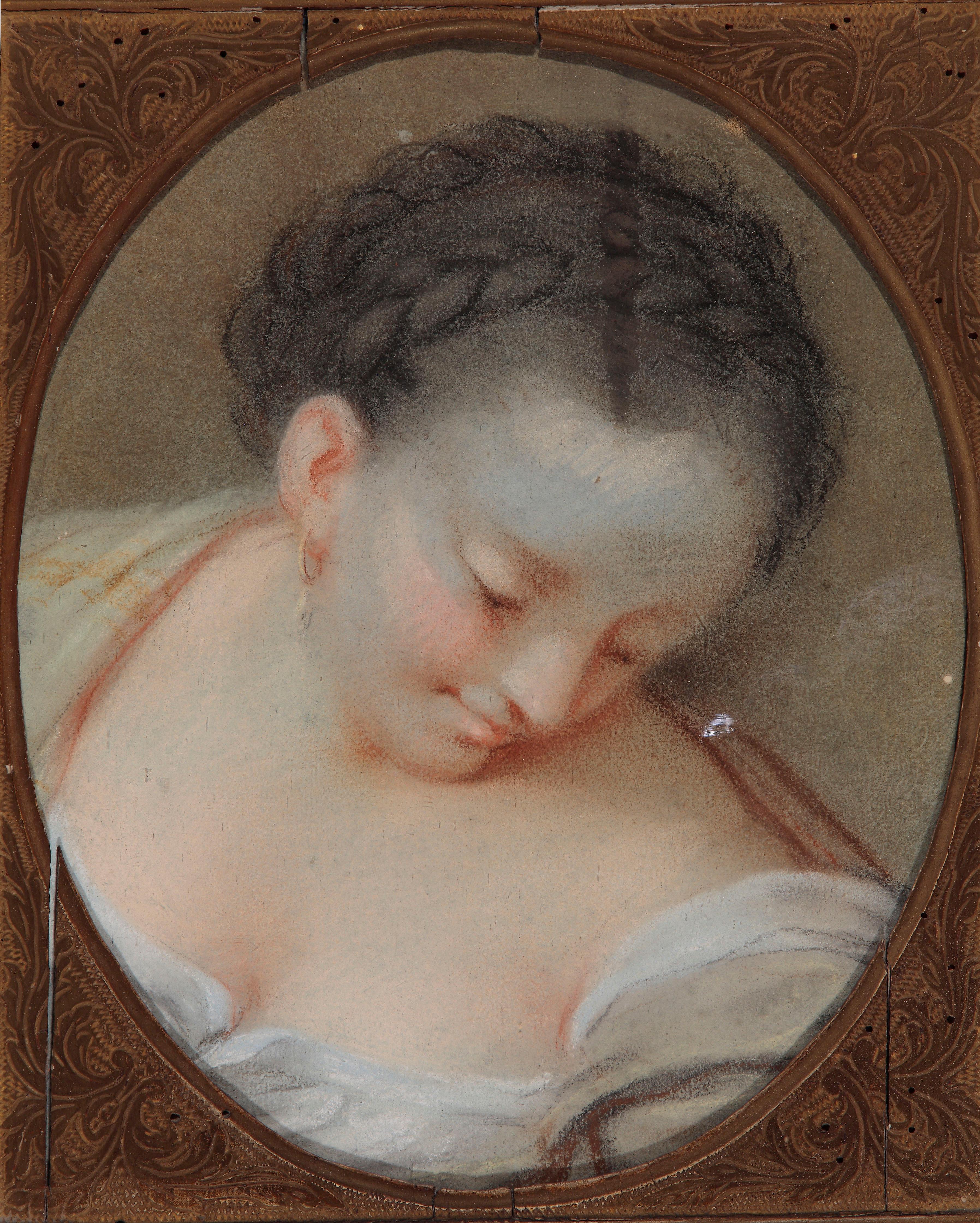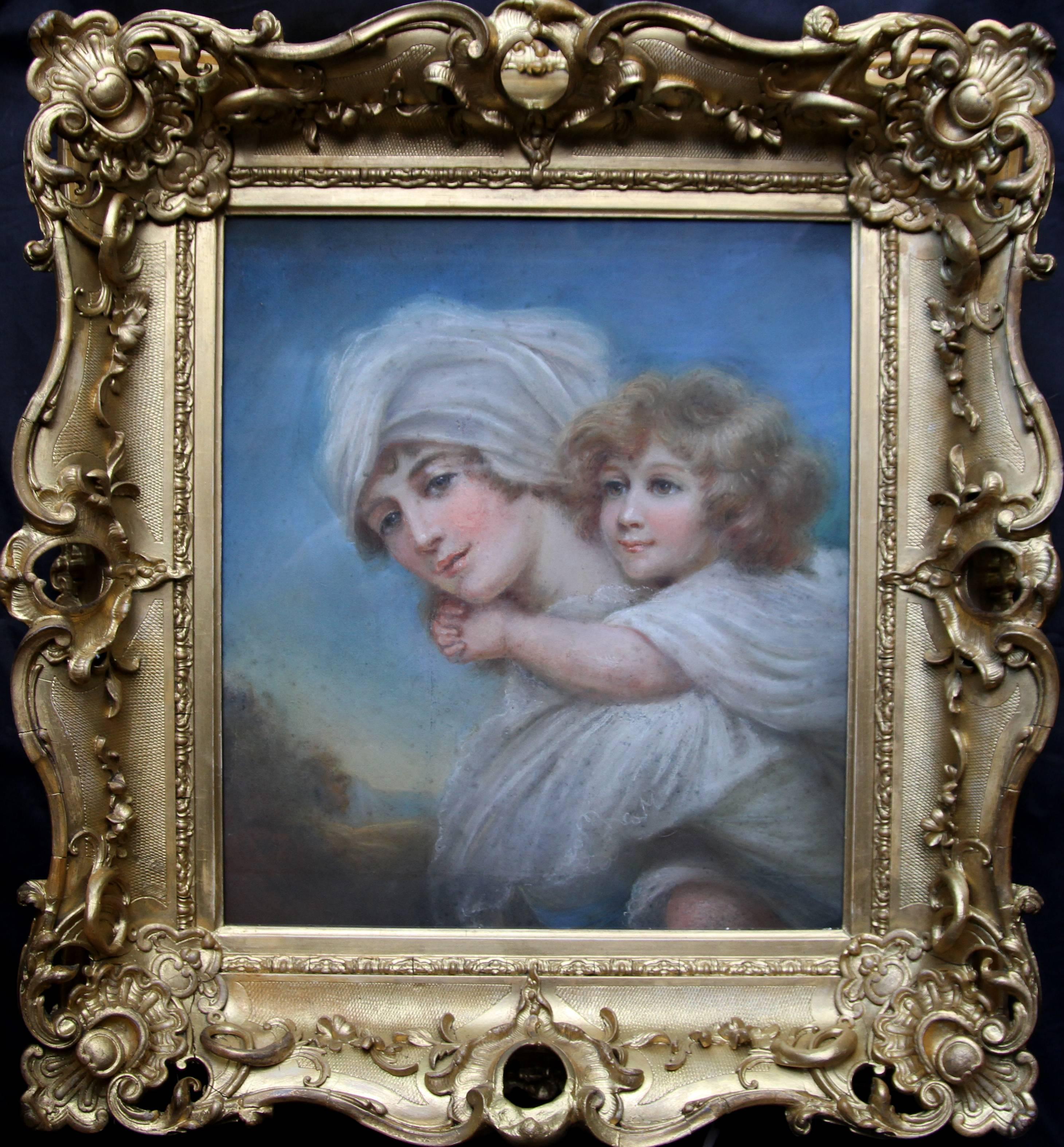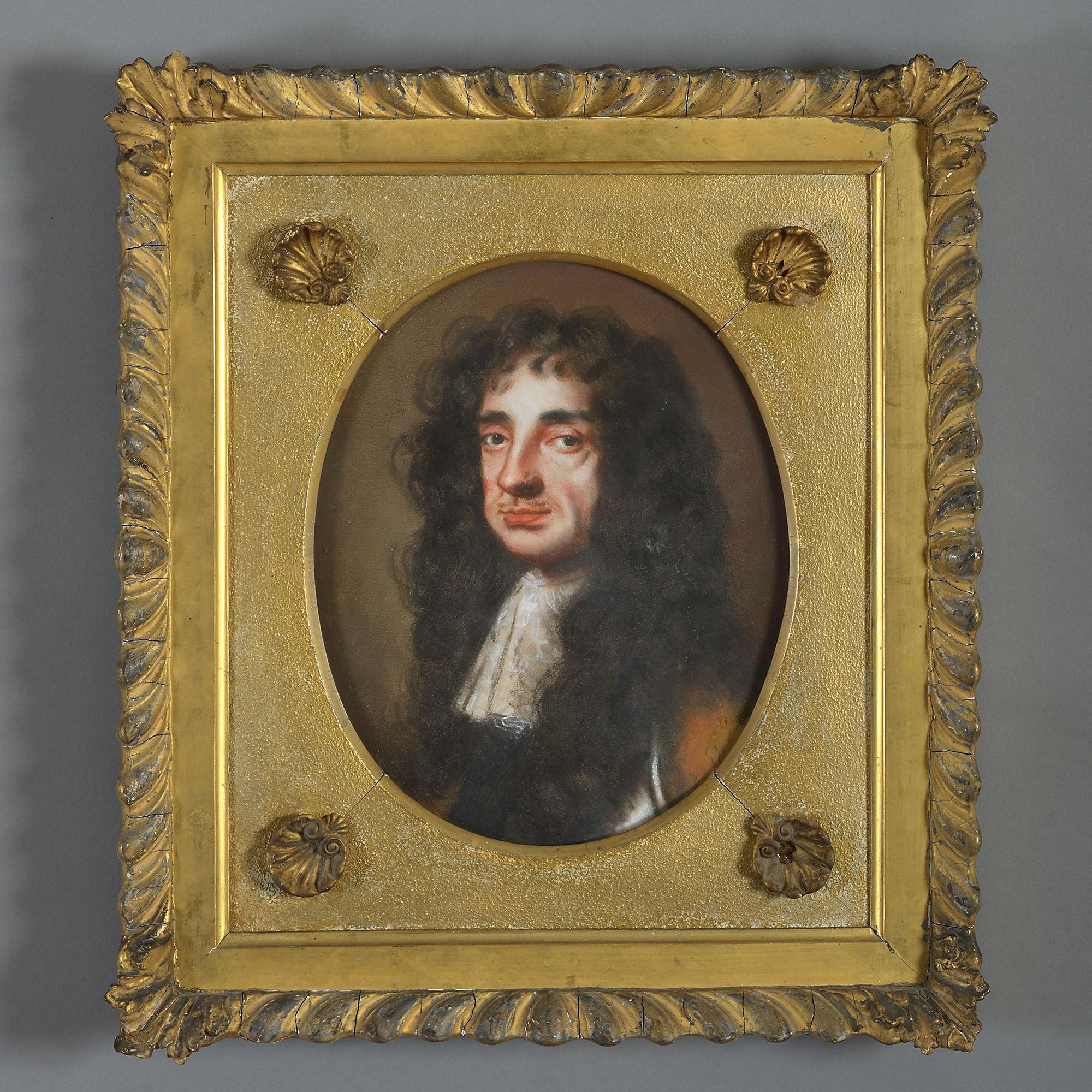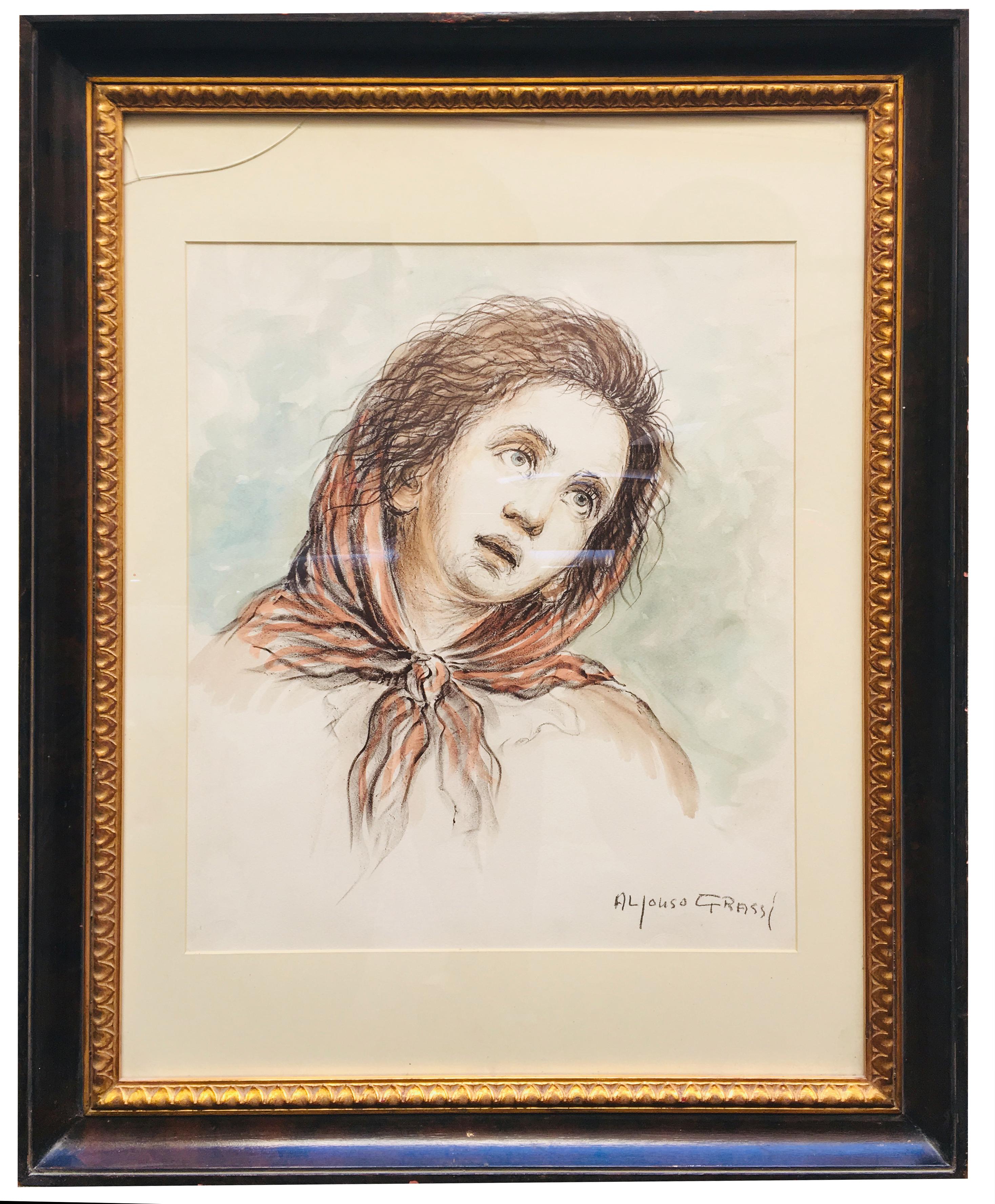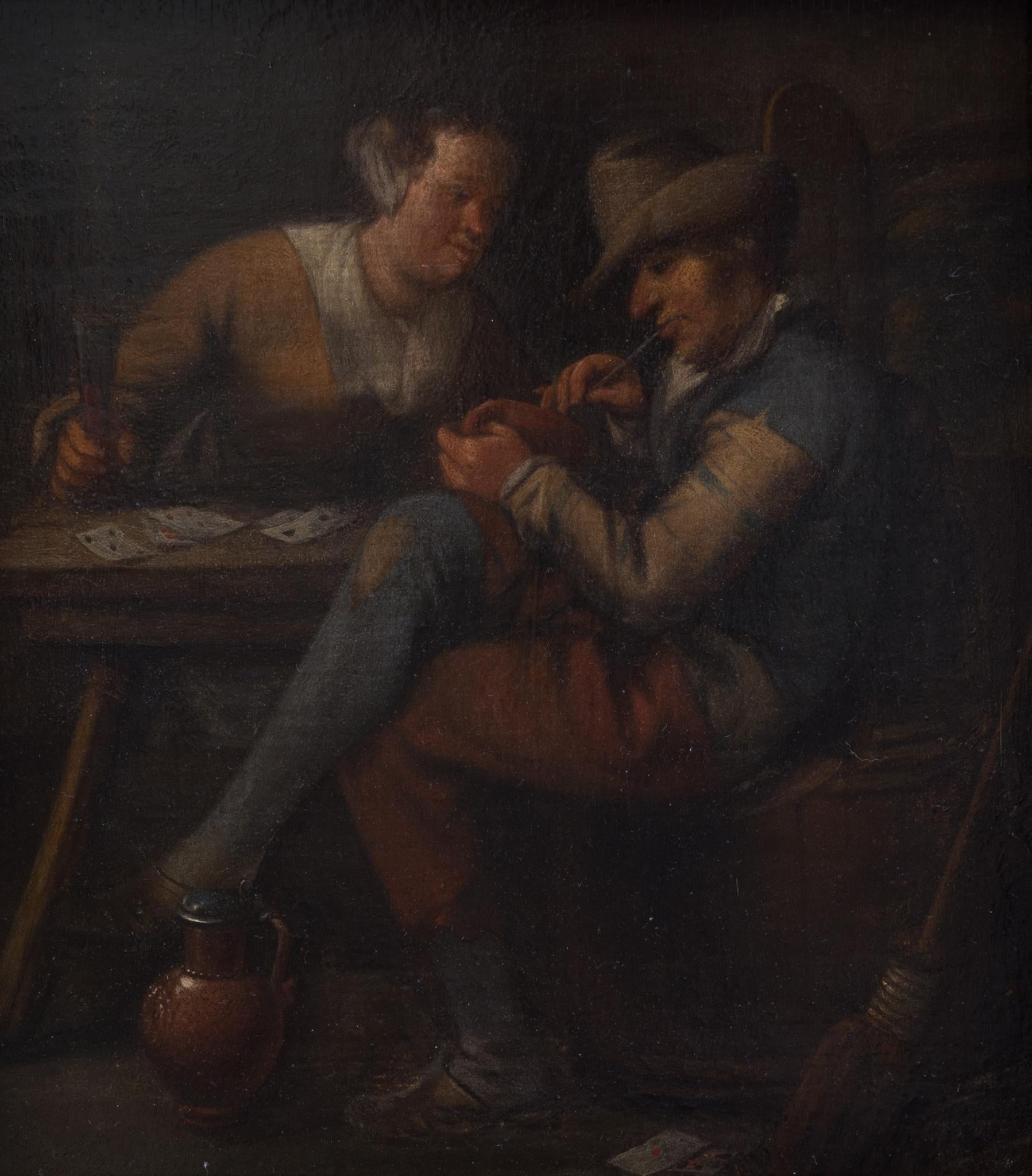Items Similar to Self-Portrait - Royal Academy Founding Member, 18th Century
Want more images or videos?
Request additional images or videos from the seller
1 of 3
Francis HaymanSelf-Portrait - Royal Academy Founding Member, 18th Century
About the Item
Francis Hayman RA
1708–1776
Self-Portrait
Oil on oak panel
Image size: 8 x 6¼ inches
Contemporary gilt frame
This newly discovered work is the earliest known self portrait by Francis Hayman, dated to the mid to late 1720’s. The small scale of the portrait gives it a strong sense of intimacy. Whereas clients would often dress themselves in their best clothes for a sitting, Hayman has portrayed himself in informal attire, with his shirt unbuttoned and a wig cap.
Born in 1708 to a respectable Devonshire family, his training began at the tender age of ten under the tutelage of the historical painter Robert Brown, who was probably an uncle. By the 1730’s he is known to have been engaged in painting scenery for the popular theatres on Goodman’s Fields and Drury Lane. He established a studio on St Martin’s Lane, and demonstrated his versatility as one of the most
important painters of his time in portraits, illustration and history painting.
Indeed, he was one of the first English painters deemed to have the skill and proficiency to rival that of the foreign masters, such as Holbein and Kneller, who were brought in by the court to make up for the perceived shortcomings of the native artists. Led by William Hogarth, Hayman and other artists began to create a new movement in the English art world. Thomas Gainsborough was one of his pupils, whom he is said to have introduced to the more lascivious and debauched underbelly of London life.
After mostly making his living as an illustrator, in the 1740’s Hayman was commissioned by the proprietor of the Vauxhall Pleasure Gardens, Jonathan Tyers, to produce a series of four large celebratory canvases depicting British victories from the Seven Years War. His association with Tyers continued, and over the next ten years he produced a number of large decorative paintings for the ornate supper boxes that were a very popular feature of the gardens.
Success as a portrait and conversation piece artist arose from his relaxed style, which cast aside the usual formal settings and poses to embrace the genteel environments of the urban middle classes in society, depicting their privileged life. These were often painted in the rococo style, which had become very popular in England in the early eighteenth century.
In 1768 Hayman is listed as a founding member of the Royal Academy, and rather ironically, given his rather wayward character, held the office of Academy Librarian from 1771 until his death in 1776. He is believed to have been married twice, although there is no surviving record of his first marriage.
Hayman died of gout in his house on Dean Street in Soho in February 1776. He is buried in an unmarked grave in nearby St Anne’s churchyard.
We are grateful to Professor Brian Allen, for confirming the attribution to Francis Hayman based on first hand examination of the work.
Literature:
- Allen, Brian, Francis Hayman, Yale University Press, (1987).
- Creator:Francis Hayman (1708 - 1776, British)
- Dimensions:Height: 8 in (20.32 cm)Width: 6.5 in (16.51 cm)
- Medium:
- Movement & Style:
- Period:
- Condition:
- Gallery Location:London, GB
- Reference Number:1stDibs: LU5246845362
About the Seller
5.0
Vetted Seller
These experienced sellers undergo a comprehensive evaluation by our team of in-house experts.
Established in 2007
1stDibs seller since 2014
Typical response time: 4 hours
- ShippingRetrieving quote...Ships From: London, United Kingdom
- Return PolicyA return for this item may be initiated within 3 days of delivery.
More From This SellerView All
- Portrait of an Officer, Cornelius Johnson, 17th Century Old MastersBy Cornelius JohnsonLocated in London, GBCircle of Cornelius Johnson Circa 1620’s Portrait of a Officer Oil on canvas Image size: 28 x 24 inches Period style hand made frame Provenance Private European Estate This striking portrait dates to around 1620, as you can see from the images of the sash the detail is very high. The sash is decorated with gold thread and would have cost a small fortune at the time. Sashes were originally developed for a military function (making officers more visible for their men during combat), but soon became a primarily male fashion...Category
Early 17th Century Old Masters Portrait Paintings
MaterialsOil
- Portrait of Thomas Cromwell 1st Earl of Essex, English School 17th CenturyLocated in London, GBEnglish School 17th Century Portrait of Thomas Cromwell 1st Earl of Essex Oil on canvas Image size: 24 x 20 inches Giltwood decorated frame PROVENANC...Category
17th Century Old Masters Portrait Paintings
MaterialsOil
- Portrait of a Young Man - 17th Century Portrait in OilBy Pieter Harmensz VerelstLocated in London, GBCircle of Pieter Harmensz Verelst 1618 - 1678 Portrait of a Young Man Oil on oak panel Image size: 7 ½ x 5 ¾ inches Dutch ripple frameCategory
18th Century and Earlier Old Masters Portrait Paintings
MaterialsPanel, Oil
- Portrait of a Girl, 18th Century Oil Old MasterBy George KnaptonLocated in London, GBGeorge Knapton 1698-1778 Portrait of a Girl Oil on canvas Image size: 20 x 18 inches Original giltwood frame This beautiful half length portrait of a young woman, turned to left, gazing at the spectator, wearing a pink, white lace-embroidered, dress, in her hair a pink bonnet trimmed with lace to match her dress. The depiction of a young girl epitomises child portraiture of the late eighteenth century, in which painters such as William Beechey, Joshua Reynolds, Thomas Gainsborough had begun to discover and express the true character of children, in contrast to the stiff, miniature-adults of previous generations. The Artist Knapton was born in Lymington, one of four sons of James Knapton. He was apprenticed to Jonathan Richardson from 1715 to 1722, and in 1720 was a founding subscriber to the academy of St. Martin's Lane established by Louis Chéron...Category
18th Century Old Masters Portrait Paintings
MaterialsOil, Canvas
- Portrait of Conrad Friedrich Hurlebusch, Early 18th Century Oil PaintingBy Dominicus van der SmissenLocated in London, GBDominicus van der Smissen Early 18th Century Portrait of Conrad Friedrich Hurlebusch Oil on canvas Image size: 20½ x 16¼ inches Period gilt frame This is a portrait of Conrad Friedrich Hurlebusch, composer, Kapellmeister and organist, whom Van der Smissen most probably portrayed during his stay in Hamburg, Brunswick or Amsterdam. The identification is based on the reproduction of the portrait which was engraved by Pieter Anthony Wakkerdak (1740- 1774). Van der Smissen has reduced the face of the sitters to an egg-shaped oval in three-quarter view, applying diminution to one half of the figure’s torso, which is farther away from the viewer. This partial side view, with the head turned to look at the viewer over the shoulder, creates spatial depth and brings the figure to life by avoiding the stiffness of a frontal depiction. Because the artist chose to highlight the figure from above, a distinct shadow is cast under the tip of the nose, in the shape of a triangle. This is an often recurring and almost ‘signature’-like feature in Van der Smissen’s oeuvre. Hurlebusch's garments are of a very high quality and serve to reflect the sitter’s wealth, status and elegance. During this period, gentlemen often shaved their heads in order to facilitate the wearing of a wig, which wouldbe worn with a suit. Here Hurlebusch has been depicted in a luxurious turban-like cap lined with lynx fur, a highly fashionable and expensive material at the time. Over his shirt, he wears a velvet fur-lined gown adorned with decorative clasps fashioned from silver braid. The elegant informality of his appearance can be seen in his unbuttoned shirt and the unfastened black ribbon hanging from his button hole, which has been artfully arranged into a fluttering drape by the portraitist. The Sitter Hurlebusch was born in Brunswick, Germany. He received the first instructions in his field from his father Heinrich Lorenz Hurlebusch, who was also a musician. As an organ virtuoso, he toured Europe, visiting Vienna, Munich and Italy. From 1723 to 1725 he was Kapellmeister in Stockholm; later he became Kapellmeister in Bayreuth and Brunswick, and lived in Hamburg from 1727 to 1742, where he had contact with fellow composers Johann Mattheson and Georg Philipp Telemann. He made his living composing, performing and teaching. In 1735 and 1736, he is believed to have visited Johann Sebastian Bach in Leipzig, who promoted Hurlebusch’s compositions as the local seller...Category
Early 18th Century Old Masters Portrait Paintings
MaterialsOil, Canvas
- Portrait of a Gentleman, 17th Century Dutch Old Masters OilLocated in London, GBCircle of Gerard van Honthorst 1592 - 1656 Portrait of a Gentleman Oil on wooden panel Image size: 29 x 23 inches Contemporary gilt frame Gerard van Honthorst was a Dutch Golden Age...Category
17th Century Old Masters Portrait Paintings
MaterialsWood Panel, Oil
You May Also Like
- 17th-18th Century By Benedetto Luti Head of a Girl Oil Pastel on CanvasLocated in Milano, LombardiaOriginal "cassetta" frame in carved, gilded wood. Expertise by Prof. Giancarlo Sestieri.Category
18th Century Old Masters Portrait Paintings
MaterialsCanvas, Oil Pastel
- 17th-18th Century By Benedetto Luti Head of a Girl Oil Pastel on CanvasLocated in Milano, LombardiaOriginal "cassetta" frame in carved and gilded wood. Expertise by Prof. Giancarlo Sestieri.Category
18th Century Old Masters Portrait Paintings
MaterialsCanvas, Oil Pastel
- Woman and Child - Old Master Regency portrait painting Mother carrying infantLocated in London, GBA superb, large Regency circa 1820 portrait of the finest quality. It depicts a lovely young woman holding a child on her back. The portrait is framed behind glass in a magnificent d...Category
Early 19th Century Old Masters Portrait Paintings
MaterialsOil Pastel
- CHILD - Alfonso Grassi Pastel on paper Portrait italian PaintingBy Alfonso GrassiLocated in Napoli, ITCHILD - Pastel on paper cm.51x41 signed lower right by Alfonso Grassi, Italy. Wooden frame with passeportout cm.94x73Category
Late 20th Century Old Masters Portrait Paintings
MaterialsPastel, Paper
- Late 17th Century Pastel Portrait of King Charles IILocated in London, GBAn important late 17th century pastel portrait depicting King Charles II of England. Edmund Ashfield (1640-1678) King Charles II, circa 1675 Paste...Category
Late 17th Century Old Masters Portrait Paintings
MaterialsPastel, Gouache
- The Card Players by a Flemish 1600s ArtistBy Flemish School, 17th CenturyLocated in Stockholm, SEFlemish 1600s School The Card Players oil on oak panel panel dimensions 22.5 x 20 cm frame included Provenance: From a Swedish private collection. Condition: Flat and stabl...Category
17th Century Old Masters Figurative Paintings
MaterialsOak, Oil, Panel
Recently Viewed
View AllMore Ways To Browse
Antique Found
Artist Self Portrait
Life Size Portrait
England Portrait
New England Portraits
Large Scale Portrait
English Royal Painting
Antique Self
Royal Street
English 18th Century Art
Late 18th Century Royal
Oil Royal England
Francis First
18th Century New England
Old England 18th Century
Old English 18th Century
Early Eighteenth Century
18th Century England Painting

